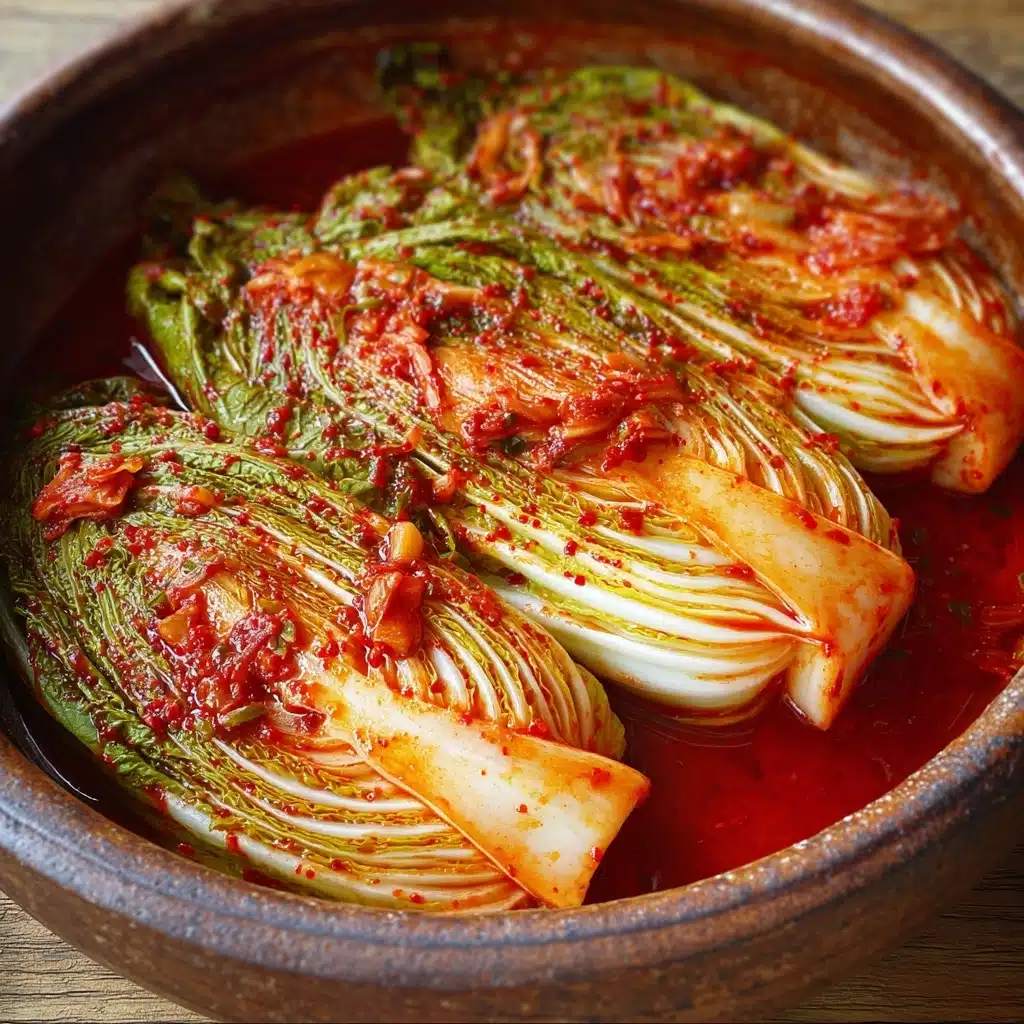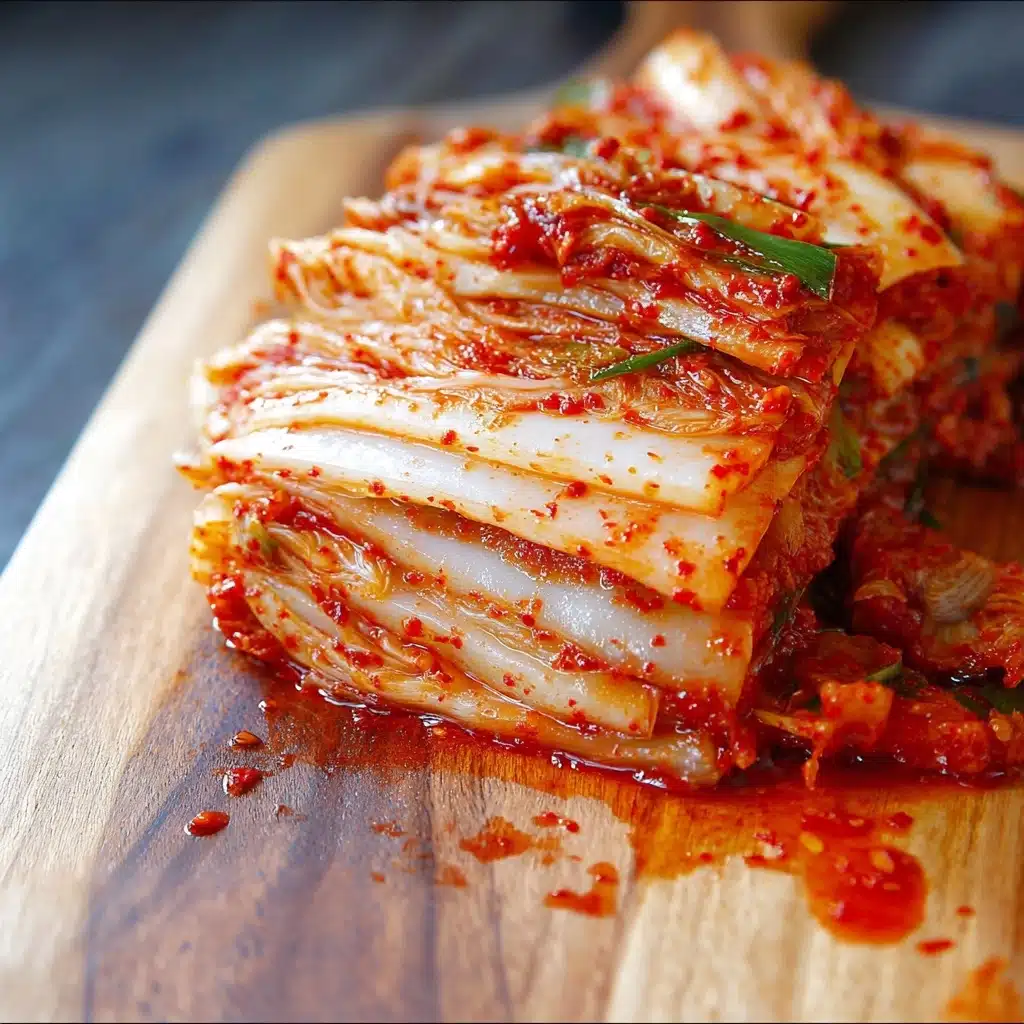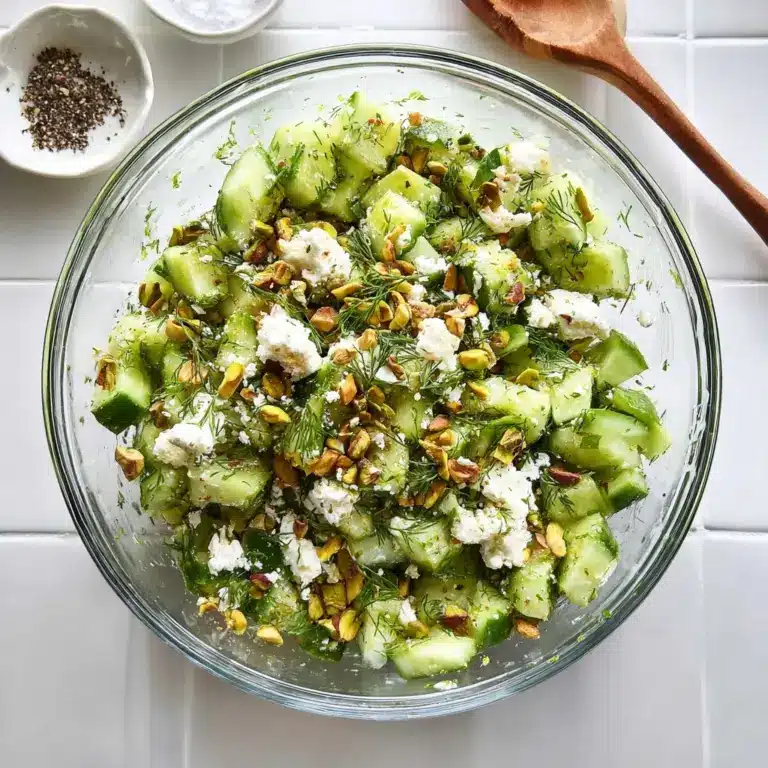Traditional kimchi (Pogi Kimchi) Recipe
Traditional kimchi (Pogi Kimchi) is pure comfort—spicy, tangy, crunchy, and bursting with the bright flavors of Korea’s favorite fermented cabbage. Whether you want to chase away the winter blues or just enjoy a daily dose of probiotic goodness, this classic recipe transforms humble ingredients into something complex and deeply satisfying. With each bite, you’ll experience layers of flavor and a satisfying texture that comes only from homemade, carefully fermented kimchi. Get ready to unlock a timeless staple that’s just as much a tradition as it is a treat!

Ingredients You’ll Need
The beauty of Traditional kimchi (Pogi Kimchi) lies in its medley of vibrant, naturally flavorful ingredients. Each component has a job to do—bringing a pop of color, crunch, or that addictive tangy heat. Here’s what you’ll need to assemble this iconic dish at home, complete with tips to make your batch truly exceptional.
- Napa cabbage: The star of the show, providing tender, crisp leaves that soak up all the spicy, salty goodness.
- Korean coarse sea salt: Essential for drawing out moisture and jumpstarting fermentation—don’t substitute with table salt!
- Water: Used for both bathing and salting the cabbage, as well as making a smooth rice paste binder.
- Korean radish (mu): This brings a juicy crunch and earthy flavor to your kimchi’s filling.
- Korean pear (optional): Adds gentle sweetness and a lovely fruity aroma for a little extra depth.
- Scallions: Offer a fresh, peppery accent to balance out the rich flavors.
- Dried kelp (dasima, optional): Simmered for broth, this gives your kimchi a subtle umami foundation.
- Glutinous rice flour: Thickens the seasoning paste so it sticks to every leaf perfectly.
- Gochugaru (Korean red pepper flakes): The soul of traditional kimchi (Pogi Kimchi)—choose coarse flakes for color and medium heat.
- Saeujeot (salted, fermented shrimp): Brings deep, savory funk and armfuls of umami to the ferment.
- Myulchiaekjeot (fish sauce): Intensifies the savoriness and helps create authentic Korean flavor.
- Raw shrimp (optional): Finely minced, these add a briny burst for an extra-traditional touch.
- Minced garlic: Infuses the kimchi with bold, aromatic depth.
- Grated ginger: Lends a warming note that cuts through the spice and salt for balance.
- Water or dasima broth: Helps meld the seasoning paste and bathe your soon-to-be-fermented masterpiece.
- Large bowls or pots: Needed for brining and mixing everything together with plenty of elbow room.
- Large colander: For draining and airing out the cabbage leaves after they’ve been salted and rinsed.
- Kitchen gloves: Absolutely necessary to protect your hands from the spicy gochugaru and strong fish sauce.
- Airtight container or jar: Keeps the kimchi tightly packed and free from unwanted air as it ferments.
How to Make Traditional kimchi (Pogi Kimchi)
Step 1: Prepare the Cabbage
Start by halving your Napa cabbage lengthwise, then gently pull each half apart to keep the leaves intact—this rustic splitting method ensures that all the leaves hold together during salting and fermentation. Once you’ve quartered each piece, you’ll have the perfect base to soak up all those vibrant flavors.
Step 2: Salt and Bathe the Cabbage
Dissolve half your coarse sea salt into a large bowl of water and give each cabbage quarter a good soak. Immediately after, gently shake off any excess water and move the cabbage to a fresh bowl. This initial brining opens the leaves and starts to draw out water—think of it as prepping your canvas!
Step 3: Salt Between the Leaves
Take the remaining salt and, starting from the outside, sprinkle it generously over the thick white stems of each leaf. Don’t be shy—this is what ensures every morsel gets seasoned and ferments just so. Repeat with all quarters, then pour your leftover saltwater over the top and set everything aside for 6 to 8 hours, rotating the cabbages every 2 to 3 hours for even salting.
Step 4: Rinse and Drain
Once the cabbage stems are soft and pliable but still a little resistant, rinse each piece three times—get in between the leaves for a thorough clean. Drain well in a colander, cut side down. Proper rinsing is the secret to avoiding an overly salty finished kimchi.
Step 5: Make the Broth and Rice Paste
While your cabbage is draining, simmer a bit of dried kelp in water to make a quick, umami-rich broth. Separately, whisk the glutinous rice flour into water (or kelp broth) and cook it over low heat until you get a thin, glossy paste. Allow both to cool completely—these steps add subtle sweetness and help the seasonings cling to every leaf.
Step 6: Prepare the Seasoning Mix
Combine your minced garlic, ginger, chopped saeujeot, and rice paste with gochugaru, fish sauce, the (optional) raw shrimp, and some water or dasima broth. Mix thoroughly until the gochugaru brightens and thickens. Let the mixture sit a while for the flavors to develop into a spicy, head-turning aroma.
Step 7: Mix the Filling
Julienne the radish and (if using) Korean pear into crisp matchsticks and toss into a large bowl. Add the diagonally sliced scallions, then fold in your seasoning paste. Don gloves here, and mix everything by hand until well coated, letting it rest for about 30 minutes to meld. It should taste punchy and just a little too salty at this stage, perfect for fermentation.
Step 8: Fill the Cabbage
Trim off the tough bottom stem of each cabbage quarter (keep enough to hold the leaves together). Working one at a time, slip seasoning between every leaf, using about a quarter of the mix per cabbage. Be generous but try not to overstuff—this ensures even fermentation.
Step 9: Wrap and Pack for Fermentation
Fold each quarter over toward the stem, neatly wrapping it up in the outermost leaf. Arrange them, cut side up, in your airtight container. Use any loose leaves to cover the top. Pour any remaining seasoning, rinsed from your bowl with a splash of water or broth, over the kimchi. Press down firmly to eliminate air pockets, then seal tightly.
Step 10: Fermentation
Let your packed cabbage ferment at room temperature for one to two days, depending on how tangy you like it and your kitchen’s temperature. Once the kimchi is fragrant and slightly bubbly, move it to the refrigerator to continue fermenting slowly—it’s ready to enjoy, but deepens in flavor over time.
How to Serve Traditional kimchi (Pogi Kimchi)

Garnishes
Traditional kimchi (Pogi Kimchi) doesn’t need much fuss—just a sprinkle of extra scallions or toasted sesame seeds can add a lovely visual touch and a subtle nutty aroma. If you’re feeling fancy, a few slivers of Korean pear or radish can brighten the plate and add extra crunch.
Side Dishes
Serve your kimchi as the hero of a banchan spread alongside steaming bowls of rice, grilled meats (samgyeopsal is a match made in heaven), or comforting soups. Its acidity and heat cut through fatty foods or rich stews, making every bite balanced and lively.
Creative Ways to Present
For a playful twist, try slicing your traditional kimchi (Pogi Kimchi) into bite-sized rolls or layering it atop open-faced rice bowls. You can also tuck it into savory pancakes (kimchi jeon), stir it through fried rice, or serve as an unexpected upgrade to a cheese toastie for an East-meets-West treat.
Make Ahead and Storage
Storing Leftovers
Pack any leftover traditional kimchi (Pogi Kimchi) tightly into a clean, airtight container to keep it fermenting gently in the fridge. Properly stored, it matures beautifully, developing deeper flavors and tang over several weeks—just make sure the cabbage stays submerged in its vibrant juices!
Freezing
While freezing traditional kimchi (Pogi Kimchi) isn’t common, you can portion excess kimchi (especially if it’s overly ripe) into freezer-safe bags for up to three months. Thaw in the fridge before using; it’s best for cooking, like kimchi stew or fried rice, as the texture softens.
Reheating
Traditional kimchi (Pogi Kimchi) is almost always served chilled or at room temperature. If you’d like to use it in hot dishes, simply add directly to your favorite soups, stews, or stir-fries—no special reheating required, just let it warm up in the pan and watch the flavors bloom!
FAQs
Can I adjust the spice level in traditional kimchi (Pogi Kimchi)?
Absolutely! The amount of gochugaru you use directly controls the heat level. For a milder kimchi, start with less and taste as you go—remember, the fermentation process develops complexity, so don’t be afraid of a little kick.
How long should I ferment my kimchi before eating?
At room temperature, a day or two is enough to kick off fermentation, but the flavors deepen over the first week or more in the fridge. Taste along the way to discover your ideal balance of crispness and tang.
What if I can’t find Korean radish or pear?
If Korean radish isn’t available, daikon makes a great substitute. No pear? Just skip it or use a crisp, sweet apple for a similar freshness—traditional kimchi (Pogi Kimchi) is adaptable!
Why does my kimchi smell so strong?
A pungent aroma is a good sign your kimchi is fermenting as it should! The combination of garlic, fish sauce, and shrimp can be bold, but rest assured, those powerful flavors transform over time into delicious complexity.
Can I make this traditional kimchi (Pogi Kimchi) vegetarian?
Yes! Swap out the fish sauce and saeujeot for a mix of soy sauce and extra kelp broth. While the flavor profile changes, you’ll still get an umami-rich, tangy kimchi everyone can enjoy.
Final Thoughts
There’s something almost magical about opening a jar of homemade traditional kimchi (Pogi Kimchi)—the scent, the vivid color, and the knowledge that you’ve created a living, evolving dish packed with history and flavor. Trust yourself, dive into the process, and soon you’ll have a delicious centerpiece that brightens any table and keeps you coming back for “just one more bite.”
PrintTraditional kimchi (Pogi Kimchi) Recipe
Learn how to make traditional Kimchi (Pogi Kimchi) with this easy-to-follow recipe. This classic Korean dish features Napa cabbage, Korean radish, seasonings, and a fermentation process that results in a flavorful and probiotic-rich side dish.
- Prep Time: 1 hour
- Cook Time: N/A
- Total Time: 1-2 days
- Yield: 1 gallon 1x
- Category: Side Dish
- Method: Fermentation
- Cuisine: Korean
- Diet: Vegetarian
Ingredients
Main Ingredients:
- 1 large Napa cabbage (about 5 to 6 pounds or 2 small)
- 1 cup Korean coarse sea salt
- 5 cups water
- 1 pound Korean radish
- 1/4 large Korean pear (optional)
Seasonings:
- 3–4 scallions
- 1 piece dasima (dried kelp)
- 1 tablespoon glutinous rice flour
- 1/2 cup gochugaru (adjust to taste)
- 1/4 cup saeujeot (salted and fermented shrimp)
- 3 tablespoons myulchiaekjeot (fish sauce)
- 3–4 raw shrimps, minced (optional)
- 3 tablespoons minced garlic
- 1 teaspoon grated ginger
- 1/2 cup water or dasima broth
Instructions
- Prepare the Cabbage: Cut cabbage into quarters, soak in salt water, and salt each leaf.
- Wash the Cabbage: Rinse thoroughly after salting.
- Make Seasonings: Prepare rice paste, garlic, ginger, and seasoning mix.
- Prepare Radish Mix: Cut radish and pear, mix with seasoning, and add scallions.
- Stuff the Cabbage: Fill cabbage leaves with radish mix and wrap.
- Ferment: Leave kimchi at room temperature for a day or two, then refrigerate.
Notes
- 1. Use loose large leaves to cover the top of the kimchi.
- 2. Adjust fermentation time based on preference.
Nutrition
- Serving Size: 1 serving (100g)
- Calories: 40
- Sugar: 2g
- Sodium: 950mg
- Fat: 0.5g
- Saturated Fat: 0g
- Unsaturated Fat: 0.5g
- Trans Fat: 0g
- Carbohydrates: 8g
- Fiber: 2g
- Protein: 2g
- Cholesterol: 5mg
Keywords: Kimchi recipe, traditional Korean kimchi, homemade kimchi








